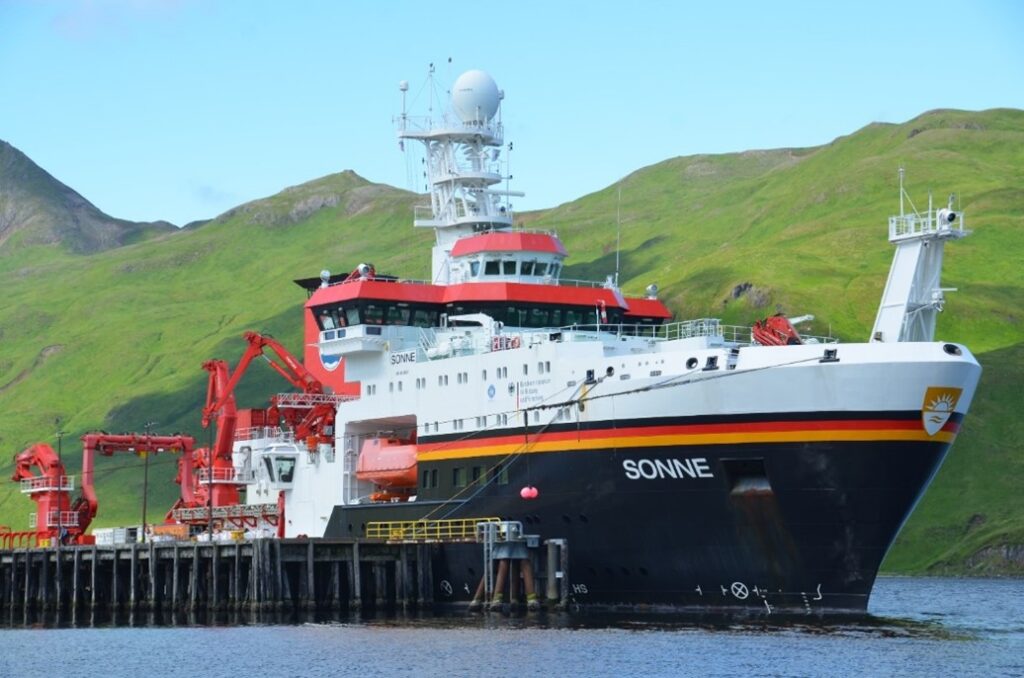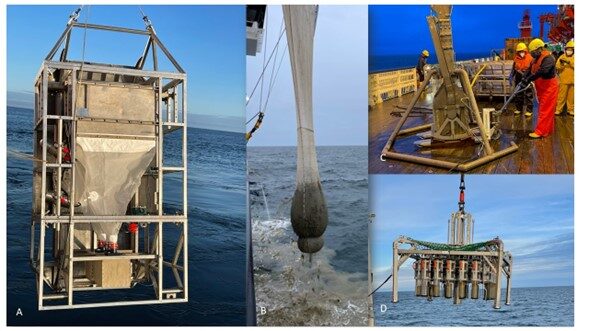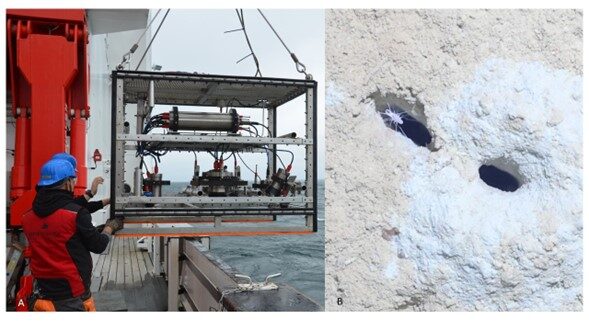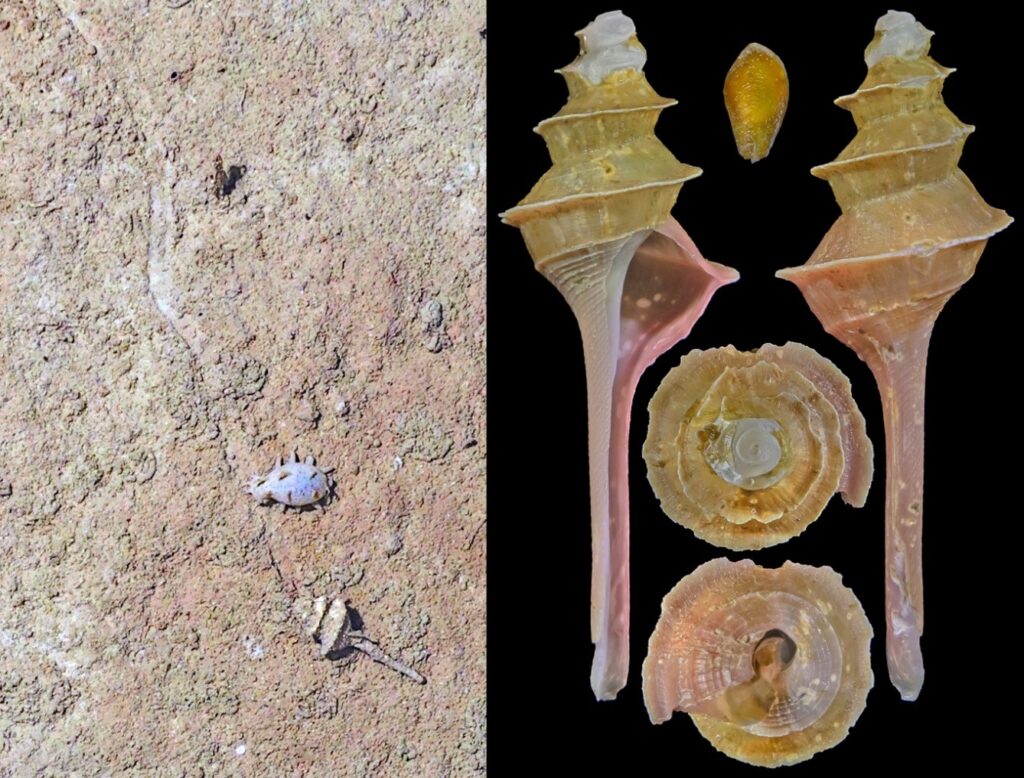Expedition Update: Exploring the Aleutian Trench

RV Sonne at its mooring in Dutch Harbor.
Report by ocean scientists Angelika Brandt, Julia Swigart, and Elva Escobar
The original Challenger voyages in the 19th Century unfortunately did not reach the higher latitudes of the Pacific. However, Challenger’s legacy continues to inspire explorers to all places where the deep-sea fauna is poorly known. This July, we embarked on a mission to the north Pacific in Dutch harbor (Unalaska, Aleutian Islands, Alaska, USA) on the German research vessel RV Sonne for the AleutBio (Aleutian Trench Biodiversity Studies) expedition. Our mission is to study the biodiversity associated with the soft sediment floor and deep-water column both within the Aleutian Trench and along the canyon’s north and south ridges.
AleutBio contributes to the UN Decade for Ocean Exploration in close collaboration with the Challenger 150 project and coordinates with DOSI (The Deep Ocean Stewardship Initiative). In addition to conducting our scientific program, we update a daily blog for public outreach and occasionally post on Instagram @aleutbio (when the ship’s internet allows).
Mission to the Deep
Our sampling during this six-week expedition is designed to shed light on the distribution of marine organisms and contribute to our understanding of changes in biodiversity and its distribution in the North Pacific, the gateway to the Arctic. AleutBio (SO293) is analysing seafloor organisms of all sizes (protists, meio-, macro- and megafauna) in addition to conducting biogeochemical studies, in the eastern Bering Sea as well as in the abyssal and hadal areas of the eastern Aleutian Trench. We plan to describe biodiversity, highlight biogeographic relationships, and examine species connectivity with the Arctic Ocean and Kuril-Kamchatka Trench in times of rapid climate change. Bathymetric mapping will be used to explore the bottom topography to define the most appropriate location for instrument deployment.
We plan to compare our new biological samples from the eastern Aleutian Trench with the biological samples from the sampling areas of previous expeditions, KuramBio I and II, and from previous Russian expeditions. That work will include integrative taxonomic work on key species that may be critical to understanding and clarifying relationships. In addition, we will use standard molecular techniques as the basis for phylogeographic surveys and connectivity studies, as well as state-of-the-art genomic techniques to integrate the data into in-depth phylogenetic analyses.
We have already completed the first two weeks of research, uncovering some satisfying results and unexpected surprises from the deep seafloor. Here are a few highlights!
A “Big” Find
Among larger animals found so far, one dominant group is the isopods. We have now recovered the largest known specimen of the genus Paropsurus (Munnopsidae). There are two females of different sizes, the largest being 65 mm long. Torben Wolff had described the largest species before now, Paropsurus giganteus Wolf, 1962, with a specimen of 60 mm length from the material of the Galathea expeditions 1962 from the Tasman Sea as well as the East Pacific waters of Costa Rica between 3570 and 4400 m depth. Our species is very similar to P. giganteus, but also has noticeable differences.
Wide-Ranging Species
In two stations south of the Aleutian Islands, a large number of amphipods were brought aboard the RV Sonne deck in four epibenthic sled samples from which 59 specimens could be sorted out. A rough morphological identification allowed the distinction of representatives of the genus Rhachotropis, most likely Rachotropis saskia Lörz & Jażdżewska, 2018. This recently described Northwest Pacific species has a very wide bathymetric distribution of over 3,000 m (~5000-8000m), which was also confirmed by molecular biology. This species also occurs on both sides of the Kuril-Kamchatka Trench (KKT) and in the trench itself (Lörz et al. 2018; DOI 10.7717/peerj.4887) and has now apparently been detected in the eastern Aleutian Trench. Species of the genus Rhachotropis are known predators and have good swimming abilities. The present result sheds new light on the distribution of deep-sea species when also confirmed by molecular studies. This result shows that our hypothesis is correct that at least some species also have a wide geographic distribution. Selected individuals of the species were preserved so that they can be used for further trophic level or proteomic analyses in the home laboratory.
Hot on the Snail Trail
Our OFOS (Ocean Floor Observation System) videos help us understand our samples, and sometimes we can even make a direct comparison with the species we collected using the other instruments. We can see the tracks organisms leave in the mud, and even delicate species can sometimes be recovered in good condition.
With greetings to the DOSI and Challenger 150 teams,
Angelika Brandt, Julia Sigwart and Elva Escobar Briones on behalf of the AleutBio team.
You can follow the next steps of the AleutBio expedition on its daily blog and on Instagram.
—






